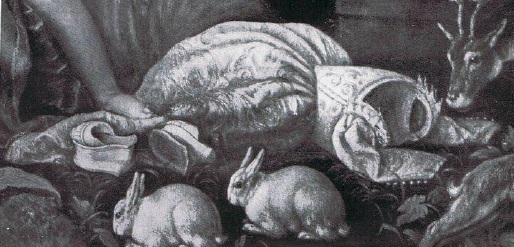I have read many articles that state in the 16th century, Italian women did not wear corsets or “stays” underneath their gowns. In one such article it was stated that Eleanor of Toledo was likely much loved by her dressing maid as she took the time despite the fear of malaria to dress her in a pair of bodies and gown for burial, as bodies where not commonly worn, but she was known to wear them for the support of her back. As can be seen in many of the portraits of the time the bodices did not wrinkle like they would if made of just the soft outer fabric. Tailors reinforced the bodices with something that they referred to as “cardboard.” Now, what comes to our mind at that word might be a cereal box or a corrugated box, but what they actually meant was linen or other fibers reinforced with glue much like a modern day interfacing. This piece of a painting of a dress laying on the ground is a good example of that.

In this black and white print, in which we can see a dress on the ground, it is clear that the bodice is stiff enough that it almost looks like a body is still inside it, whereas the sleeves and skirt drape
differently. This seems to be a clear example of the level of stiffness that the bodices of the time would have had. https://www.sammlung.pinakothek.de/en/bookmark/artwork/ApL8WYAkxN
Skirts were made from large pieces pleated to a bodice. The many gores we tend to cut seems wasteful and not really a good way to protect an investment. As clothing was as much as 40 percent of the household budget at that time. Dressing a family for a fancy wedding might cause them to borrow money and then resell the fabric after the wedding. Fabric cut into large pieces like I intend would make the fabric more sale able.
After looking at all of this I have chosen to put two layers of buckram in my gown giving it a nice stiff bodice. Also to make my bodice more like Vittoria Colonna’s portraits as I could not find a good portrait of a contrasting bodice to use as documentation. I also have chosen to pleat a large box of fabric for my skirt.
I have many unfinished things at this time so no new pictures of progress but I promise to have a lot for Sunday.
Some links to my sources:
http://www.shushanna.com/italian.html
https://katerina.purplefiles.net/garb/diaries/FLSOTTANA_Grey_Linen.html

